Spring Aop源码分析
开头
aop部分的解析器由AopNamespaceHandler注册,其init方法:
@Override
public void init() {
registerBeanDefinitionParser("config", new ConfigBeanDefinitionParser());
registerBeanDefinitionParser("aspectj-autoproxy", new AspectJAutoProxyBeanDefinitionParser());
registerBeanDefinitionDecorator("scoped-proxy", new ScopedProxyBeanDefinitionDecorator());
}
aop:config
此标签用以配置pointcut, advisor, aspect,实例:
<aop:config>
<aop:pointcut expression="execution(* exam.service..*.*(..))" id="transaction"/>
<aop:advisor advice-ref="txAdvice" pointcut-ref="transaction"/>
<aop:aspect ref="" />
</aop:config>
ConfigBeanDefinitionParser.parse:
@Override
public BeanDefinition parse(Element element, ParserContext parserContext) {
CompositeComponentDefinition compositeDef =
new CompositeComponentDefinition(element.getTagName(),
parserContext.extractSource(element));
parserContext.pushContainingComponent(compositeDef);
// 是否生成代理类
configureAutoProxyCreator(parserContext, element);
List<Element> childElts = DomUtils.getChildElements(element);
for (Element elt: childElts) {
String localName = parserContext.getDelegate().getLocalName(elt);
if (POINTCUT.equals(localName)) {
parsePointcut(elt, parserContext);
} else if (ADVISOR.equals(localName)) {
parseAdvisor(elt, parserContext);
} else if (ASPECT.equals(localName)) {
parseAspect(elt, parserContext);
}
}
parserContext.popAndRegisterContainingComponent();
return null;
}
解析
解析的过程主要分为以下几个部分。
proxy-target-class & expose-proxy
对应着aop:config的两个属性,前者代表是否为被代理这生成CGLIB子类,默认false,只为接口生成代理子类(话说如果不生成子类那么怎么拦截?)。后者代表是否将代理bean暴露给用户,如果暴露,可以通过Spring AopContext类获得,默认不暴露。
解析的过程无非就是属性的读取,不再详细说明。
aop:pointcut
pointcut的解析是一个生成一个BeanDefinition并将其id, expression等属性保存在BeanDefinition中。注意以下几点:
- BeanDefinition的ID来自于id属性,如果没有,那么自动生成。
- BeanDefinition的class是AspectJExpressionPointcut。
- BeanDefinition的scope为prototype。
AspectJExpressionPointcut类图:
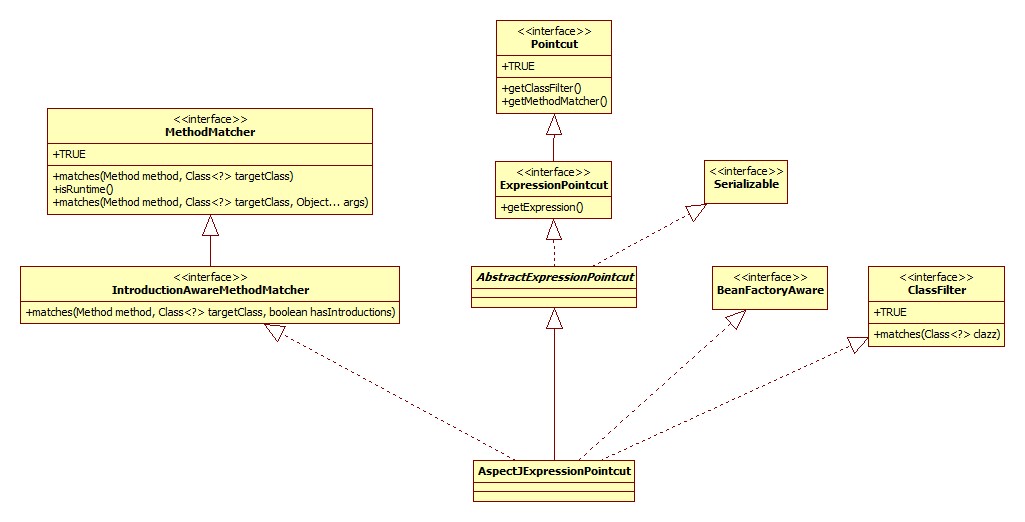
aop:advisor
首先是其所有属性的示例:
<aop:advisor id="" order="" advice-ref="aopAdvice" pointcut="" pointcut-ref="" />
advisor概念是Spring独有的,来自于上古时代,应该是较早时候的aop概念的实现: AOP Alliance (Java/J2EE AOP standards)。Spring官方的说法: aop-schema-advisors。
其相关的包/类就在spring-aop下:
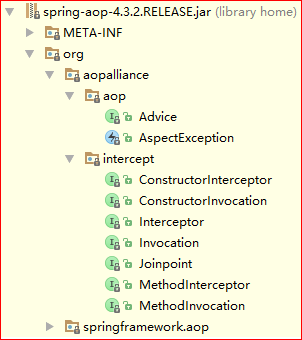
advice-ref是必须的属性,并且这里的advice必须实现org.aopalliance.aop.Advice的子接口。这些子接口指的什么呢,见Spring官方文档: aop-api-advice-types。比如org.aopalliance.intercept.MethodInterceptor。
最常见的用途就是结合事务使用:
<tx:advice id="txAdvice" transaction-manager="transactionManager">
<tx:attributes>
<tx:method name="get*" read-only="true" propagation="NOT_SUPPORTED"/>
<tx:method name="find*" read-only="true" propagation="NOT_SUPPORTED"/>
<tx:method name="*" propagation="REQUIRED"/>
</tx:attributes>
</tx:advice>
<aop:config>
<aop:pointcut expression="execution(* exam.service..*.*(..))" id="transaction"/>
<aop:advisor advice-ref="txAdvice" pointcut-ref="transaction"/>
</aop:config>
解析的套路和楼上类似,只不过此处的beanClass是DefaultBeanFactoryPointcutAdvisor,其类图:
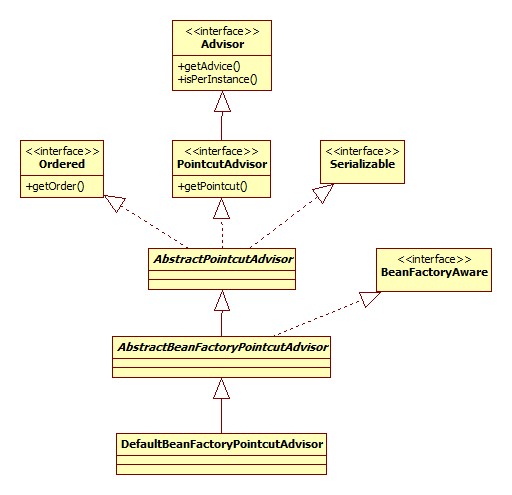
另外注意对于pointcut和pointcut-ref两者处理的区别,对于pointcut属性,Spring会同样创建一个AspectJExpressionPointcut类型的BeanDefinition,对于pointcut-ref会生成一个RuntimeBeanReference对象指向原pointcut的引用。此类的类图:
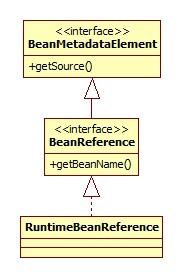
可以看出,这种aop的实现需要实现各种接口,所以不应该再使用此种方式进行aop,除了Spring内部的实现。
aop:aspect
配置举例:
<bean id="aopAdvice" class="base.aop.AopDemoAdvice" />
<!-- 必须配置,因为被代理的对象必须在Spring容器中 -->
<bean id="aopDemo" class="base.aop.AopDemo" />
<aop:config>
<aop:pointcut id="pointcut" expression="execution(* base.aop.AopDemo.send())" />
<aop:aspect ref="aopAdvice">
<aop:before method="beforeSend" pointcut-ref="pointcut" />
<aop:after method="afterSend" pointcut-ref="pointcut" />
</aop:aspect>
</aop:config>
解析形成的BeanDefinition结构如下:
AspectComponentDefinition
beanRefArray
RuntimeBeanReference(aop:aspect的ref属性)
beanDefArray
// 被注册
RootBeanDefinition(aop:declare-parents)
beanClass: DeclareParentsAdvisor
ConstructorArg
implement-interface
types-matching
default-impl
delegate-ref
// 被注册
RootBeanDefinition(aop:before,aop:after...)
beanClass: AspectJPointcutAdvisor
ConstructorArg
RootBeanDefinition
beanClass: 由子标签决定
ConstructorArg
RootBeanDefinition
beanClass: MethodLocatingFactoryBean
properties
targetBeanName: aspectName
methodName: method属性
RootBeanDefinition
beanClass: SimpleBeanFactoryAwareAspectInstanceFactory
properties
aspectBeanName: aspectName
//还有pointcut定义和引用...
结构图里面的aspectName来自于aop:aspect的ref属性,此属性是必须配置的,因为Spring要知道aop:before等标签指定的方法是哪个bean/类/对象的方法。
aop:declare-parents
对于aop:declare-parents子标签,其决定的是代理子类应该实现哪些接口:
<aop:declare-parents types-matching="" implement-interface="" />
此标签最终被解析成为beanClass为DeclareParentsAdvisor的BeanDefinition,并注册到容器中。其类图:
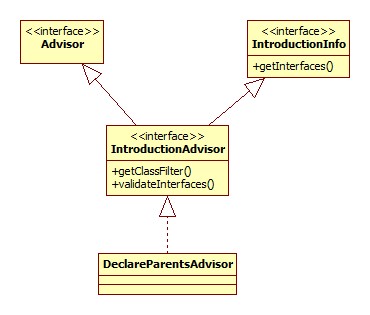
其它
此处的其它指的是aop:before, aop:after等最核心的标签。其最终被解析为beanClass为AspectJPointcutAdvisor的BeanDefinition,类图:
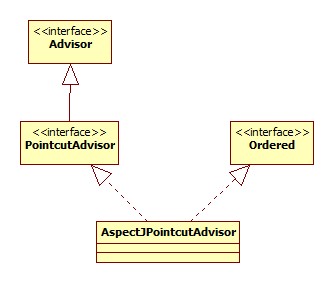
正如上面结构图里所描述的,其构造参数为一个BeanDefintion,此对象的beanClass是不确定的,由aop:before/after中的before和after决定,代码:
private Class<?> getAdviceClass(Element adviceElement, ParserContext parserContext) {
String elementName = parserContext.getDelegate().getLocalName(adviceElement);
if (BEFORE.equals(elementName)) {
return AspectJMethodBeforeAdvice.class;
} else if (AFTER.equals(elementName)) {
return AspectJAfterAdvice.class;
} else if (AFTER_RETURNING_ELEMENT.equals(elementName)) {
return AspectJAfterReturningAdvice.class;
} else if (AFTER_THROWING_ELEMENT.equals(elementName)) {
return AspectJAfterThrowingAdvice.class;
} else if (AROUND.equals(elementName)) {
return AspectJAroundAdvice.class;
}
}
而此BeanDefintion的构造参数又由以下三个部分组成:
MethodLocatingFactoryBean
第一个便是beanClass为此类型的BeanDefinition。其内部有一个methodName属性,存储的便是标签的method属性的值。其类图:
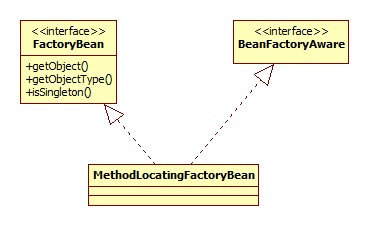
这个东西是干什么用的呢?其实是用于在指定的advice(aop:aspect的ref属性)中得到Method对象。入口在setBeanFactory方法:
@Override
public void setBeanFactory(BeanFactory beanFactory) {
Class<?> beanClass = beanFactory.getType(this.targetBeanName);
this.method = BeanUtils.resolveSignature(this.methodName, beanClass);
}
SimpleBeanFactoryAwareAspectInstanceFactory
其类图:
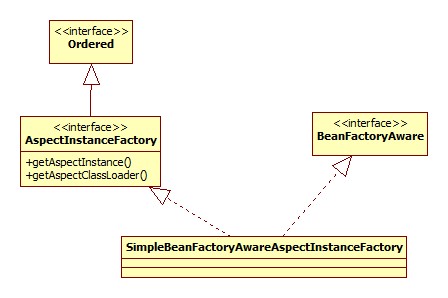
此类用于在BeanFactory中定位aspect bean,这个bean指的是谁?
<bean id="aopAdvice" class="base.aop.AopDemoAdvice" />
就是它!查找很简单:
@Override
public Object getAspectInstance() {
return this.beanFactory.getBean(this.aspectBeanName);
}
总结
从整个aop:aspect标签最终被解析为一个AspectJPointcutAdvisor来看,Spring在实现上仍将其作为Advisor的概念。
代理子类生成
关键在于AspectJAwareAdvisorAutoProxyCreator,此对象在ConfigBeanDefinitionParser的configureAutoProxyCreator方法中注册,其类图:
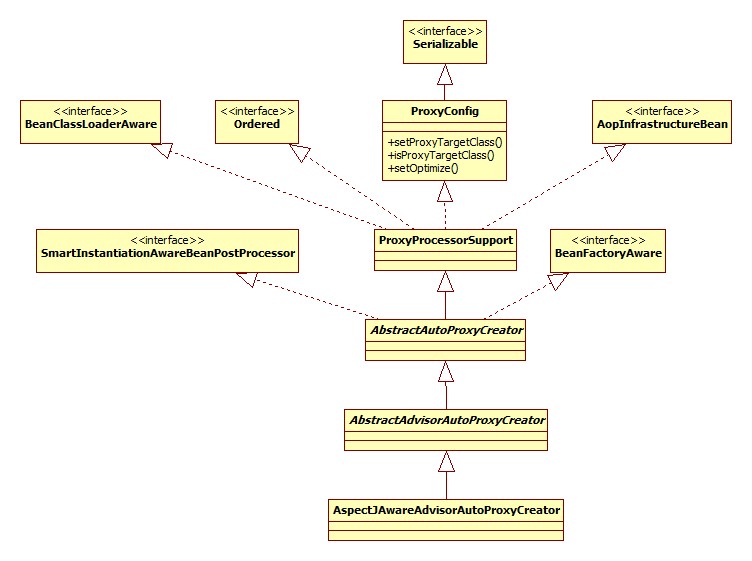
那么子类生成的入口在哪里呢?
入口
从AspectJAwareAdvisorAutoProxyCreator的类图中可以看出,此类实现了SmartInstantiationAwareBeanPostProcessor接口,所以很容易想到入口应该位于此接口及其父接口(BeanPostProcessor)的相关方法中。实际上确实是这样的。
postProcessBeforeInstantiation
调用时机
先来回顾一下此方法在Bean创建的过程中的调用时机。
AbstractAutowireCapableBeanFactory.createBean部分源码:
//// Give BeanPostProcessors a chance to return a proxy instead of the target bean instance.
Object bean = resolveBeforeInstantiation(beanName, mbdToUse);
if (bean != null) {
return bean;
}
Object beanInstance = doCreateBean(beanName, mbdToUse, args);
可以看出,调用发生在Bean实例的创建之前。
源码
AbstractAutoProxyCreator.postProcessBeforeInstantiation:
@Override
public Object postProcessBeforeInstantiation(Class<?> beanClass, String beanName) {
Object cacheKey = getCacheKey(beanClass, beanName);
if (beanName == null || !this.targetSourcedBeans.contains(beanName)) {
if (this.advisedBeans.containsKey(cacheKey)) {
return null;
}
if (isInfrastructureClass(beanClass) || shouldSkip(beanClass, beanName)) {
this.advisedBeans.put(cacheKey, Boolean.FALSE);
return null;
}
}
if (beanName != null) {
TargetSource targetSource = getCustomTargetSource(beanClass, beanName);
if (targetSource != null) {
this.targetSourcedBeans.add(beanName);
Object[] specificInterceptors =
getAdvicesAndAdvisorsForBean(beanClass, beanName, targetSource);
Object proxy = createProxy(beanClass, beanName, specificInterceptors, targetSource);
this.proxyTypes.put(cacheKey, proxy.getClass());
return proxy;
}
}
return null;
}
下面分部分对其进行说明。
应该代理 ?
Spring首先会对当前的beanClass进行检查(是否应该/可以对其进行代理)。
不应该代理的类分为两种情况:
- 用于实现AOP的Spring基础类,此种情况在isInfrastructureClass方法中完成检测(单词Infrastructure正是基础设施的意思)。
- 子类定义的应该跳过的类,默认AbstractAutoProxyCreator的实现直接返回false,即都不应该跳过。
基础类检测
AbstractAutoProxyCreator.isInfrastructureClass:
protected boolean isInfrastructureClass(Class<?> beanClass) {
boolean retVal = Advice.class.isAssignableFrom(beanClass) ||
Pointcut.class.isAssignableFrom(beanClass) ||
Advisor.class.isAssignableFrom(beanClass) ||
AopInfrastructureBean.class.isAssignableFrom(beanClass);
return retVal;
}
可以看出,任何Advice、Pointcut、Advisor、AopInfrastructureBean的子类都被当做Spring实现AOP的基础设施类。
跳过类检测
即shouldSkip方法。前面提到了,AbstractAutoProxyCreator的默认实现直接返回fasle,这一特性被子类AspectJAwareAdvisorAutoProxyCreator重写:
@Override
protected boolean shouldSkip(Class<?> beanClass, String beanName) {
List<Advisor> candidateAdvisors = findCandidateAdvisors();
for (Advisor advisor : candidateAdvisors) {
if (advisor instanceof AspectJPointcutAdvisor) {
if (((AbstractAspectJAdvice) advisor.getAdvice()).getAspectName().equals(beanName)) {
return true;
}
}
}
return super.shouldSkip(beanClass, beanName);
}
那么此方法跳过的是谁呢?
其实就是我们通过aop:aspect标签配置的切面,即:
<bean id="aopAdvice" class="base.aop.AopDemoAdvice" />
<aop:config>
<aop:aspect ref="aopAdvice">
</aop:aspect>
</aop:config>
里的aopAdvice。
从前面的aop:aspect一节中可以知道,Spring对于aop:config的解析其实是把aop:before/after等标签解析成为了AspectJPointcutAdvisor类型的BeanDefinition,而aopAdvice以AbstractAspectJAdvice的类型保存在其中。
所以可以得出结论: Spring跳过的是适用于当前bean的Advisor的Advice/Aspect对象。
AOP逻辑
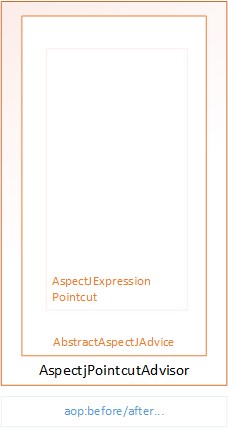
那么Spring又是如何找到适用于当前bean的Advisor的呢?
Advisor寻找
关键便是findCandidateAdvisors方法,此方法将逻辑委托给BeanFactoryAdvisorRetrievalHelper.findAdvisorBeans:
public List<Advisor> findAdvisorBeans() {
String[] advisorNames = null;
synchronized (this) {
// 结果缓存
advisorNames = this.cachedAdvisorBeanNames;
if (advisorNames == null) {
// 去容器中寻找
advisorNames = BeanFactoryUtils.beanNamesForTypeIncludingAncestors(
this.beanFactory, Advisor.class, true, false);
this.cachedAdvisorBeanNames = advisorNames;
}
}
if (advisorNames.length == 0) {
return new LinkedList<Advisor>();
}
List<Advisor> advisors = new LinkedList<Advisor>();
for (String name : advisorNames) {
if (isEligibleBean(name)) {
if (!this.beanFactory.isCurrentlyInCreation(name)) {
advisors.add(this.beanFactory.getBean(name, Advisor.class));
}
}
}
return advisors;
}
可以看出,首先是从容器中获取到所有的Advisor示例,然后调用isEligibleBean方法逐一判断Advisor是否适用于当前bean。
适用性检测
指的便是isEligibleBean方法。最终调用的是AbstractAdvisorAutoProxyCreator的同名方法:
protected boolean isEligibleAdvisorBean(String beanName) {
return true;
}
而AbstractAdvisorAutoProxyCreator的子类AspectJAwareAdvisorAutoProxyCreator并没有覆盖此方法,所以此处会对容器中所有的Advisor的Advice进行跳过。
检测结果缓存
因为postProcessBeforeInstantiation方法会在每个bean初始化之前被调用,所以没有必要每次都真的进行基础类检测和跳过类检测,Spring使用了advisedBeans作为缓存用以提高性能。
TargetSource
从源码中可以看出,对于自定义的TargetSource,Spring会立即执行代理子类的创建。Spring的代理其实是针对TargetSource的,其类图:
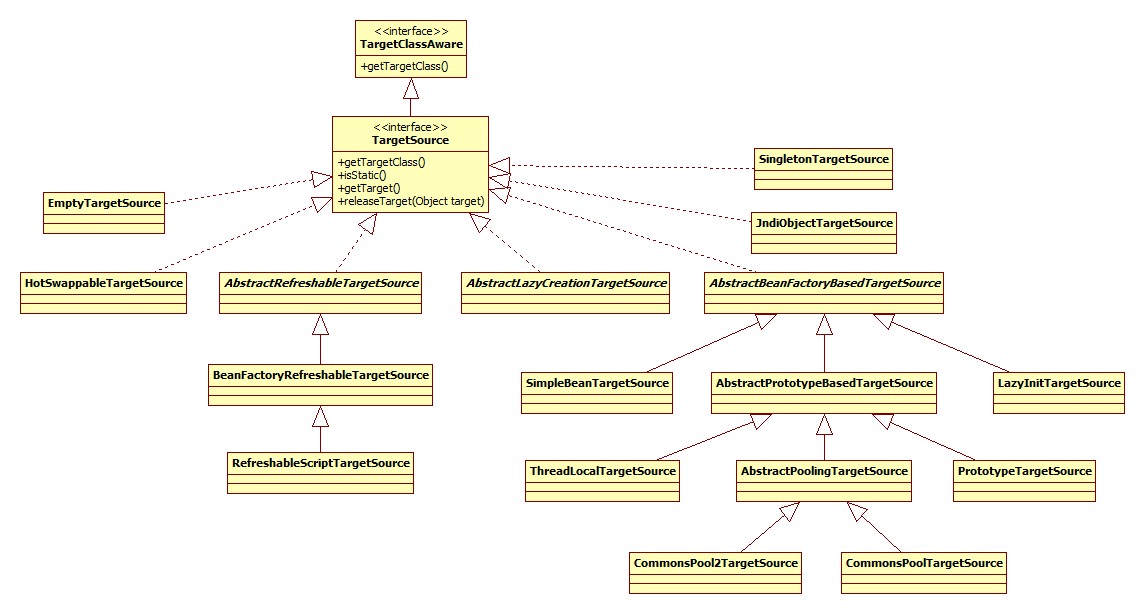
关于此接口在此不展开叙述。
postProcessAfterInitialization
AbstractAutoProxyCreator.postProcessAfterInitialization:
@Override
public Object postProcessAfterInitialization(Object bean, String beanName) {
if (bean != null) {
Object cacheKey = getCacheKey(bean.getClass(), beanName);
if (!this.earlyProxyReferences.contains(cacheKey)) {
return wrapIfNecessary(bean, beanName, cacheKey);
}
}
return bean;
}
关键便在于wrapIfNecessary方法:
protected Object wrapIfNecessary(Object bean, String beanName, Object cacheKey) {
//自定义TargetSource,已经进行过代理子类生成
if (beanName != null && this.targetSourcedBeans.contains(beanName)) {
return bean;
}
if (Boolean.FALSE.equals(this.advisedBeans.get(cacheKey))) {
return bean;
}
if (isInfrastructureClass(bean.getClass()) || shouldSkip(bean.getClass(), beanName)) {
this.advisedBeans.put(cacheKey, Boolean.FALSE);
return bean;
}
// Create proxy if we have advice.
Object[] specificInterceptors = getAdvicesAndAdvisorsForBean(bean.getClass(), beanName, null);
if (specificInterceptors != DO_NOT_PROXY) {
this.advisedBeans.put(cacheKey, Boolean.TRUE);
// 创建
Object proxy = createProxy(
bean.getClass(), beanName, specificInterceptors, new SingletonTargetSource(bean));
this.proxyTypes.put(cacheKey, proxy.getClass());
return proxy;
}
this.advisedBeans.put(cacheKey, Boolean.FALSE);
return bean;
}
可以看出,在此方法的开头又进行了基础类以及跳过类的检测,再次不再赘述。
Advisor寻找
即getAdvicesAndAdvisorsForBean方法,这里进行的便是去容器中寻找适用于当前bean的Advisor,最终调用的是
AbstractAdvisorAutoProxyCreator.findEligibleAdvisors:
protected List<Advisor> findEligibleAdvisors(Class<?> beanClass, String beanName) {
List<Advisor> candidateAdvisors = findCandidateAdvisors();
List<Advisor> eligibleAdvisors = findAdvisorsThatCanApply(candidateAdvisors, beanClass, beanName);
extendAdvisors(eligibleAdvisors);
if (!eligibleAdvisors.isEmpty()) {
eligibleAdvisors = sortAdvisors(eligibleAdvisors);
}
return eligibleAdvisors;
}
findCandidateAdvisors前面已经说过了。
适用性判断
findAdvisorsThatCanApply最终调用AopUtils.findAdvisorsThatCanApply:
public static List<Advisor> findAdvisorsThatCanApply(List<Advisor> candidateAdvisors, Class<?> clazz) {
if (candidateAdvisors.isEmpty()) {
return candidateAdvisors;
}
List<Advisor> eligibleAdvisors = new LinkedList<Advisor>();
for (Advisor candidate : candidateAdvisors) {
if (candidate instanceof IntroductionAdvisor && canApply(candidate, clazz)) {
eligibleAdvisors.add(candidate);
}
}
boolean hasIntroductions = !eligibleAdvisors.isEmpty();
for (Advisor candidate : candidateAdvisors) {
if (candidate instanceof IntroductionAdvisor) {
// already processed
continue;
}
if (canApply(candidate, clazz, hasIntroductions)) {
eligibleAdvisors.add(candidate);
}
}
return eligibleAdvisors;
}
关键在于canApply方法,从源码中可以看出,对于Advisor的判断分为了IntroductionAdvisor以及非IntroductionAdvisor两种情况。
这种分开处理导致了IntroductionAdvisor在Advisor链中总是位于非IntroductionAdvisor前面。
canApply(candidate, clazz)其实等价于canApply(candidate, clazz, false):
public static boolean canApply(Advisor advisor, Class<?> targetClass, boolean hasIntroductions) {
if (advisor instanceof IntroductionAdvisor) {
return ((IntroductionAdvisor) advisor).getClassFilter().matches(targetClass);
}
else if (advisor instanceof PointcutAdvisor) {
PointcutAdvisor pca = (PointcutAdvisor) advisor;
return canApply(pca.getPointcut(), targetClass, hasIntroductions);
}
else {
// It doesn't have a pointcut so we assume it applies.
return true;
}
}
很明显,对于引入Advisor与其它Advisor是两种不同的判断方式。
引入
引入的概念在下面aop:scoped-proxy中有提到。因为引入的目的在于动态地向一个类添加另一种功能(接口),所以只要判断给定的类是否是要引入到的类即可。
其它
AopUtils.canApply:
public static boolean canApply(Pointcut pc, Class<?> targetClass, boolean hasIntroductions) {
//是否Pointcut可以匹配当前类
if (!pc.getClassFilter().matches(targetClass)) {
return false;
}
MethodMatcher methodMatcher = pc.getMethodMatcher();
//是否Pointcut可以匹配所有方法
if (methodMatcher == MethodMatcher.TRUE) {
// No need to iterate the methods if we're matching any method anyway...
return true;
}
IntroductionAwareMethodMatcher introductionAwareMethodMatcher = null;
if (methodMatcher instanceof IntroductionAwareMethodMatcher) {
introductionAwareMethodMatcher = (IntroductionAwareMethodMatcher) methodMatcher;
}
Set<Class<?>> classes = new LinkedHashSet<Class<?>>
(ClassUtils.getAllInterfacesForClassAsSet(targetClass));
classes.add(targetClass);
for (Class<?> clazz : classes) {
Method[] methods = ReflectionUtils.getAllDeclaredMethods(clazz);
for (Method method : methods) {
if ((introductionAwareMethodMatcher != null &&
introductionAwareMethodMatcher
.matches(method, targetClass, hasIntroductions)) ||
methodMatcher.matches(method, targetClass)) {
return true;
}
}
}
return false;
}
Spring的Pointcut由ClassFilter和MethodMatcher两部分组成,其中前者用以判断给定的类是否在Pointcut的匹配范围内,后者用以在ClassFilter匹配满足的情况下判断给定的方法是否在Pointcut匹配的范围内。
从源码中可以看出,如果ClassFilter匹配得到满足并且Pointcut并不能匹配此类的任意方法,便会用反射的方法获取targetClass(被检测类)的全部方法逐一交由Pointcut的MethodMatcher进行检测。
关于Pointcut表达式是如何解析及存储的在此不再展开。
Advisor扩展
AbstractAdvisorAutoProxyCreator.extendAdvisors允许子类向Advisor链表中添加自己的Advisor。子类AspectJAwareAdvisorAutoProxyCreator重写了此方法,其逻辑是:
如果Advisor链表中的Advisor含有AspectJ Advice,那么将会把一个ExposeInvocationInterceptor添加到链表的表头,目的在于将MethodInvocation以ThreadLocal的方式暴露给后面所有的Advisor,暂不知道具体的用途。
排序
即sortAdvisors方法,用于对实现了Ordered接口的Advisor进行排序。
创建
AbstractAutoProxyCreator.createProxy(略去非关键代码):
protected Object createProxy(
Class<?> beanClass, String beanName, Object[] specificInterceptors, TargetSource targetSource) {
ProxyFactory proxyFactory = new ProxyFactory();
proxyFactory.copyFrom(this);
//将interceptor适配为Advisor
Advisor[] advisors = buildAdvisors(beanName, specificInterceptors);
for (Advisor advisor : advisors) {
proxyFactory.addAdvisor(advisor);
}
return proxyFactory.getProxy(getProxyClassLoader());
}
JDK动态代理 or Cglib
由DefaultAopProxyFactory.createAopProxy方法决定使用何种方式创建代理子类。
@Override
public AopProxy createAopProxy(AdvisedSupport config) throws AopConfigException {
if (config.isOptimize() || config.isProxyTargetClass() ||
hasNoUserSuppliedProxyInterfaces(config)) {
Class<?> targetClass = config.getTargetClass();
if (targetClass.isInterface() || Proxy.isProxyClass(targetClass)) {
return new JdkDynamicAopProxy(config);
}
return new ObjenesisCglibAopProxy(config);
} else {
return new JdkDynamicAopProxy(config);
}
}
逻辑很明显,如果指定了(proxy-target-classs设为true)使用Cglib,那么就会使用Cglib的方式,如果没有指定(或为false),那么先回检测被代理类是否实现了自己的接口,如果实现了,那么就采用JDK动态代理的方式。
JDK动态代理
JdkDynamicAopProxy.getProxy:
@Override
public Object getProxy(ClassLoader classLoader) {
//找到可以用来进行代理的接口
Class<?>[] proxiedInterfaces = AopProxyUtils.completeProxiedInterfaces(this.advised, true);
//用来代理的接口中是否定义了equals或者是hashCode方法?
//结果保存在内部equalsDefined和hashCodeDefined两个成员变量中
findDefinedEqualsAndHashCodeMethods(proxiedInterfaces);
return Proxy.newProxyInstance(classLoader, proxiedInterfaces, this);
}
可以看出,关键的InvocationHandler参数其实就是JdkDynamicAopProxy自身。
其invoke方法较长,源码就不贴了,下面进行分部分说明。
equals & hashCode
如果被代理类实现了equals或者是hashCode方法,那么生成的代理子类的equals、hashCode方法实际上执行的是JdkDynamicAopProxy相应方法的逻辑。
invoke方法部分源码:
if (!this.equalsDefined && AopUtils.isEqualsMethod(method)) {
// The target does not implement the equals(Object) method itself.
return equals(args[0]);
}
链式调用
对于切点方法,比如前面aop:aspect示例配置中的beforeSend
<aop:before method="beforeSend" pointcut-ref="pointcut" />
Spring会创建一个MethodInvocation对象对所有相关的Advisor进行链式调用。invoke相关源码:
List<Object> chain = this.advised.getInterceptorsAndDynamicInterceptionAdvice(method, targetClass);
invocation = new ReflectiveMethodInvocation(proxy, target, method, args, targetClass, chain);
Object retVal = invocation.proceed();
Cglib
同样是对于Advisor的链式调用,不再详细展开。
aop:scoped-proxy
此配置一般是这样使用:
<bean id="userPreferences" class="com.foo.UserPreferences" scope="session">
<aop:scoped-proxy/>
</bean>
<bean id="userManager" class="com.foo.UserManager">
<property name="userPreferences" ref="userPreferences"/>
</bean>
对于ref属性,只会在userManager初始化时注入一次。这会造成什么问题呢?以session的Scope为例,因为只会注入一次,所以,userManager引用的始终是同一个userPreferences对象,即使现在可能已经过时了。此配置便可以使userManager引用的其实是一个对代理的引用,所以可以始终获取到最新的userPreferences。
其作用和注解@ScopedProxy相同。
其解析由ScopedProxyBeanDefinitionDecorator完成,类图:

解析
入口
从类图可以看出,ScopedProxyBeanDefinitionDecorator和之前的解析器都不同,它的调用入口不同以往:
DefaultBeanDefinitionDocumentReader.processBeanDefinition:
protected void processBeanDefinition(Element ele, BeanDefinitionParserDelegate delegate) {
BeanDefinitionHolder bdHolder = delegate.parseBeanDefinitionElement(ele);
if (bdHolder != null) {
// 装饰
bdHolder = delegate.decorateBeanDefinitionIfRequired(ele, bdHolder);
}
}
BeanDefinitionParserDelegate.decorateIfRequired:
public BeanDefinitionHolder decorateIfRequired(
Node node, BeanDefinitionHolder originalDef, BeanDefinition containingBd) {
String namespaceUri = getNamespaceURI(node);
if (!isDefaultNamespace(namespaceUri)) {
NamespaceHandler handler = this.readerContext.getNamespaceHandlerResolver()
.resolve(namespaceUri);
if (handler != null) {
return handler.
decorate(node, originalDef, new ParserContext(this.readerContext, this, containingBd));
}
}
return originalDef;
}
一目了然。
这么做(装饰)的原因就是此标签是用在bean内部的,从decorate的方法签名可以看出,第二个便是父(bean)BeanDefinition,所以叫做装饰。
装饰
@Override
public BeanDefinitionHolder decorate(Node node, BeanDefinitionHolder definition, ParserContext parserContext) {
boolean proxyTargetClass = true;
if (node instanceof Element) {
Element ele = (Element) node;
if (ele.hasAttribute(PROXY_TARGET_CLASS)) {
proxyTargetClass = Boolean.valueOf(ele.getAttribute(PROXY_TARGET_CLASS));
}
}
BeanDefinitionHolder holder =
ScopedProxyUtils.
createScopedProxy(definition, parserContext.getRegistry(), proxyTargetClass);
String targetBeanName = ScopedProxyUtils.getTargetBeanName(definition.getBeanName());
// 空实现
parserContext.getReaderContext().fireComponentRegistered(
new BeanComponentDefinition(definition.getBeanDefinition(), targetBeanName));
return holder;
}
核心便是createScopedProxy方法,其源码较长,但是这个套路之前见识过了,就是一个偷天换日: 创建一个新的BeanDefinition对象,beanName为被代理的bean的名字,被代理的bean名字为scopedTarget.原名字。被代理的bean扔将被注册到容器中。
新的BeanDefintion的beanClass为ScopedProxyFactoryBean,其类图:
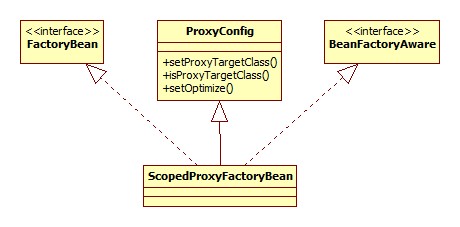
代理生成
入口便是setBeanFactory方法:
@Override
public void setBeanFactory(BeanFactory beanFactory) {
ConfigurableBeanFactory cbf = (ConfigurableBeanFactory) beanFactory;
this.scopedTargetSource.setBeanFactory(beanFactory);
ProxyFactory pf = new ProxyFactory();
pf.copyFrom(this);
pf.setTargetSource(this.scopedTargetSource);
Class<?> beanType = beanFactory.getType(this.targetBeanName);
if (!isProxyTargetClass() || beanType.isInterface() ||
Modifier.isPrivate(beanType.getModifiers())) {
// JDK动态代理可用的接口
pf.setInterfaces(ClassUtils.getAllInterfacesForClass(beanType, cbf.getBeanClassLoader()));
}
// Add an introduction that implements only the methods on ScopedObject.
ScopedObject scopedObject = new DefaultScopedObject
(cbf, this.scopedTargetSource.getTargetBeanName());
pf.addAdvice(new DelegatingIntroductionInterceptor(scopedObject));
// Add the AopInfrastructureBean marker to indicate that the scoped proxy
// itself is not subject to auto-proxying! Only its target bean is.
pf.addInterface(AopInfrastructureBean.class);
this.proxy = pf.getProxy(cbf.getBeanClassLoader());
}
这个套路上面也见过了。
Advisor
核心的拦截逻辑是通过DelegatingIntroductionInterceptor来完成的,其类图:
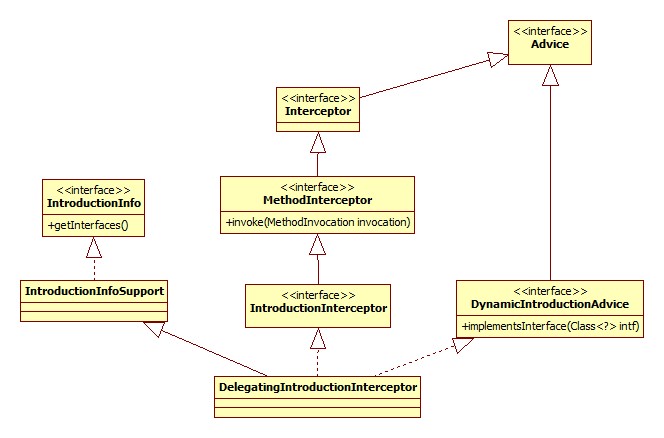
AdvisedSupport.addAdvice方法将其转化为Advisor:
@Override
public void addAdvice(int pos, Advice advice) throws AopConfigException {
if (advice instanceof IntroductionInfo) {
// We don't need an IntroductionAdvisor for this kind of introduction:
// It's fully self-describing.
addAdvisor(pos, new DefaultIntroductionAdvisor(advice, (IntroductionInfo) advice));
} else if (advice instanceof DynamicIntroductionAdvice) {
// We need an IntroductionAdvisor for this kind of introduction.
} else {
addAdvisor(pos, new DefaultPointcutAdvisor(advice));
}
}
显然,DelegatingIntroductionInterceptor被包装为DefaultIntroductionAdvisor对象。
DelegatingIntroductionInterceptor到底是个什么东西呢?这其实就引出了Spring的Introduction(引入)概念。
引入
通常意义上的Spring AOP一般是在方法层面上进行逻辑的改变,而引入指的是在不修改类源码的情况下,直接为一个类添加新的功能。下面是一个引入使用的例子:
SpringAOP中的IntroductionInterceptor
例子
自定义Scope
为了便于测试,我们定义一个生存周期仅仅在于一次调用的Scope,源码:
public class OneScope implements Scope {
private int index = 0;
@Override
public Object get(String name, ObjectFactory<?> objectFactory) {
System.out.println("get被调用");
return new Student("skywalker-" + (index++), index);
}
//忽略其它方法
}
将其注册到容器中,有两种方法:
-
在代码中:
context.getBeanFactory().registerScope("one", new OneScope()); -
配置文件:
<bean class="org.springframework.beans.factory.config.CustomScopeConfigurer"> <property name="scopes"> <map> <entry key="one"> <bean class="base.scope.OneScope" /> </entry> </map> </property> </bean>
配置
此时就可以使用我们自己的Scope了:
<bean class="base.SimpleBean" id="simpleBean">
<property name="student" ref="student" />
</bean>
<bean id="student" class="base.Student" scope="one">
<aop:scoped-proxy />
</bean>
测试
执行以下代码:
SimpleBean simpleBean = context.getBean(SimpleBean.class);
System.out.println(simpleBean.getStudent().getName());
System.out.println(simpleBean.getStudent().getName());
可以看到以下输出:
get被调用
skywalker-0
get被调用
skywalker-1
可以得出结论: 当调用被代理的bean的方法时才会触发Scoped的语义,只是获得其对象(getStudent)没有效果。
原理
doGetBean
从根本上来说在于AbstractBeanFactory.doGetBean,部分源码:
//scope非prototype和Singleton
else {
String scopeName = mbd.getScope();
final Scope scope = this.scopes.get(scopeName);
Object scopedInstance = scope.get(beanName, new ObjectFactory<Object>() {
@Override
public Object getObject() throws BeansException {
beforePrototypeCreation(beanName);
try {
return createBean(beanName, mbd, args);
}
finally {
afterPrototypeCreation(beanName);
}
}
});
bean = getObjectForBeanInstance(scopedInstance, name, beanName, mbd);
}
scopes是BeanFactory内部的一个 LinkedHashMap<String, Scope>类型的对象。scope.get实际上调用的就是我们的OneSocpe的get方法,没有用到ObjectFactory。
所以,每调用一次getBean,就会导致一个新的Sudent被创建并返回。
代理子类
还有一个关键的问题,从上面可以知道SimpleBean内部的student引用其实是一个CGLIB代理子类的对象,那么当调用这个代理对象的相应方法(比如getName)时,是怎样导致Student重新创建(或是getBean被调用)的?
CallbackFilter & Callback
必须首先理解下CGLIB的这两个概念。
Callback
Callback是Cglib所有自定义逻辑(增强)的共同接口。
其简略类图:

CallbackFilter
在CGLib回调时可以设置对不同方法执行不同的回调逻辑,或者根本不执行回调。
jdk并不支持这么搞,只支持设置一个InvocationHandler处理(拦截)所有的方法。其类图:
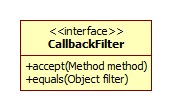
Cglib的Enhancer可以指定一个Callback数组,而accept方法的返回值是一个int值,其实就是Callback数组的下标,这样便达到了指定回调逻辑的目的。
参考:
回调
一般的方法使用的是DynamicAdvisedInterceptor作为回调逻辑,其intercept关键源码:
@Override
public Object intercept(Object proxy, Method method, Object[] args, MethodProxy methodProxy) {
Object target = getTarget();
}
target就是被代理对象。
getTarget:
protected Object getTarget() throws Exception {
return this.advised.getTargetSource().getTarget();
}
TargetSource前面说过了,默认是SimpleBeanTargetSource:
@Override
public Object getTarget() throws Exception {
return getBeanFactory().getBean(getTargetBeanName());
}
至此,真相大白。
aop:aspectj-autoproxy
此标签用以开启对于@AspectJ注解风格AOP的支持。
属性
proxy-target-class
你懂的。
expose-proxy
是否应该把代理对象暴露给AopContext,默认false。
栗子
切面
@Aspect
public class AspectDemo {
@Pointcut("execution(void base.aop.AopDemo.send(..))")
public void beforeSend() {}
@Before("beforeSend()")
public void before() {
System.out.println("send之前");
}
}
被代理类
public class AopDemo implements AopDemoInter {
public void send() {
System.out.println("send from aopdemo");
}
public void receive() {
System.out.println("receive from aopdemo");
}
@Override
public void inter() {
System.out.println("inter");
}
}
配置
<aop:aspectj-autoproxy proxy-target-class="true" />
<bean class="base.aop.AopDemo" />
<bean class="base.aop.annotation.AspectDemo" />
因为AopDemo实现了AopDemoInter接口,但做实验的send方法又不在此接口里定义,所以只能用cglib的方式代理。
可以看出,即使标注了@Aspect注解,仍然需要将切面自己配置到Spring容器中。
解析
AspectJAutoProxyBeanDefinitionParser.parse:
@Override
public BeanDefinition parse(Element element, ParserContext parserContext) {
AopNamespaceUtils.
registerAspectJAnnotationAutoProxyCreatorIfNecessary(parserContext, element);
extendBeanDefinition(element, parserContext);
return null;
}
注册最终在AopConfigUtils.registerOrEscalateApcAsRequired方法中完成,创建器实际上是一个AnnotationAwareAspectJAutoProxyCreator类的对象,此类是前面AspectJAwareAdvisorAutoProxyCreator的子类。
原理
既然是AspectJAwareAdvisorAutoProxyCreator的子类,那么其代理子类的创建等核心逻辑自然是一样的。这里所需要关注的地方自然是所不一样的地方: 即是如何体现其注解的特性的。
前面说过,AspectJAwareAdvisorAutoProxyCreator通过findCandidateAdvisors方法来找到适用于bean的Advisor,所以注解的特性也是通过重写此方法来体现。
AnnotationAwareAspectJAutoProxyCreator.findCandidateAdvisors:
@Override
protected List<Advisor> findCandidateAdvisors() {
List<Advisor> advisors = super.findCandidateAdvisors();
//这里
advisors.addAll(this.aspectJAdvisorsBuilder.buildAspectJAdvisors());
return advisors;
}
buildAspectJAdvisors方法所做的便是从容器中得到所有的bean,逐一判断是不是一个Aspect。那么判断Aspect的依据是什么?
AbstractAspectJAdvisorFactory.isAspect:
@Override
public boolean isAspect(Class<?> clazz) {
return (hasAspectAnnotation(clazz) && !compiledByAjc(clazz));
}
至于其它的实现细节不再探究。
总结
Spring对于AspectJ风格AOP的支持停留在外表(注解)上面,内部的实现仍然是自己的东西。
拾遗
AOP切面的坑
- 定义在private方法上的切面不会被执行,这个很容易理解,毕竟子类不能覆盖父类的私有方法。
- 同一个代理子类内部的方法相互调用不会再次执行切面。
这里以Cglib为例对第二点进行说明,cglib的相关核心组件可以参考前面CallbackFilter & Callback部分。对于配置了一个切面的典型场景,Spring内部的执行流程可总结如下图:

核心便是对目标方法的调用上,这里由CglibMethodInvocation的invokeJoinpoint实现:
@Override
protected Object invokeJoinpoint() throws Throwable {
if (this.publicMethod) {
return this.methodProxy.invoke(this.target, this.arguments);
} else {
return super.invokeJoinpoint();
}
}
如果是非public方法,那么Spring将使用反射的方法对其进行调用,因为反射将其可访问性设为true。MethodProxy是Cglib对方法代理的抽象,这里的关键是方法调用的对象(目标)是我们的原生类对象,而不是Cglib代理子类的对象,这就从根本上决定了对同类方法的调用不会再次经过切面。
总结
前面aop:aspectj-autoproxy-属性-expose-proxy一节提到了,Spring允许我们将代理子类暴露出来,可以进行如下配置:
<aop:config expose-proxy="true">
<aop:advisor advice-ref="simpleMethodInterceptor" pointcut="execution(* aop.SimpleAopBean.*(..))" />
</aop:config>
当我们需要在一个被代理方法中调用同类的方法时(此方法也需要经过切面),可以这样调用:
public void testB() {
System.out.println("testB执行");
((SimpleAopBean) AopContext.currentProxy()).testC();
}
这里其实是一个ThreadLocal,当Cglib代理子类创建调用链之间便会将代理类设置到其中,DynamicAdvisedInterceptor.intercept相关源码:
if (this.advised.exposeProxy) {
// Make invocation available if necessary.
oldProxy = AopContext.setCurrentProxy(proxy);
setProxyContext = true;
}


